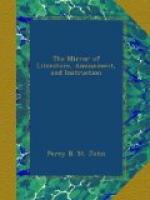I was now in a rude and barren country, presenting a strong contrast to the soft scenery I had left, and consisting of an elevated mountain plateau, or table land of slate of the Greywacke sort, the heights on the eastern side of the Rhine being of the same level, and the channel of the river appearing as a narrow valley, which the eye overlooks entirely. This table land is studded with isolated hills of volcanic formation, and of a conical form, some of them having central funnels or craters, from which the ancient eruptions have issued. The most complete are the Hirschenberg, near Burgbrohl, the Bousenberg, between that village and Olburg, the Poter, Pellenberg, and the Camillenberg, which last rises about one thousand feet above the level of the surrounding surface. There are many others extending for some distance in the Eiffel chain and in the vicinity, but those I have mentioned are sufficient to guide the footsteps of the inquirer. The basin of the Lake of Laach is nearly circular and crateriform; it is a mile and a half long, and about a mile and a quarter in breadth. Its average depth is two hundred feet, but it is full of holes, the measure of which is very uncertain. Its water is blueish, very cold, and of a nasty brackish taste. It has been examined by several geologists, British and foreign, among whom is the famous Humboldt, and there is no doubt that this great reservoir is the crater of an extinct volcano. The fragments and minerals thrown up on the banks are analogous to those found in other volcanic countries; and on one side (that towards Nieder-mennig) is a regular rock of continued lava, which is supposed to have flowed from the crater during the last eruption. Mr. Scrope, whose opinion is entitled to great weight, thinks it not improbable that this may have been the eruption recorded by Tacitus, (13 lib. Annal.,) as having ravaged the country of the Initones, near Cologne, in the reign of Nero. I should not forget to mention that there is a cavern within the basin of the lake, the air of which is so stifling and noxious, that animals die if forced to remain in it, and lights are extinguished by the gas—phenomena precisely similar to those of the well-known Grotto del Cane, near Naples.
While I am on the subject of volcanic phenomena, I may as well add a word on the origin of the trass or tufa, which is so thickly spread over this country. It is similar to that found near Naples, at Mont d’Or, Carbal, and other parts of Italy; and, indeed, all the products of the latter district are pretty nearly the same as these, allowing for the difference of a slate surface in the one case, and a sandy and alluvial soil in the other. The idea of the trass having any connexion with a deluge, is, I believe, now exploded; and geologists have agreed that it is the actual substance ejected by the volcano, subsided into a firm paste. The rain has always been observed to fall heavily after eruptions, and the water running down the sides of




